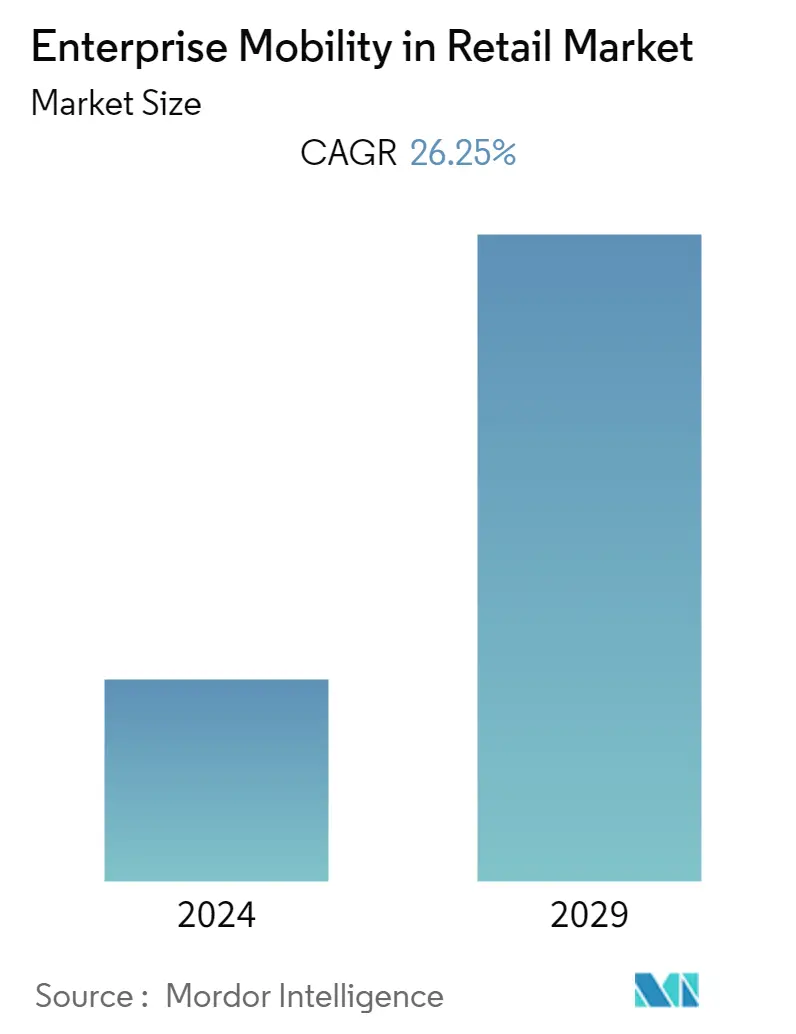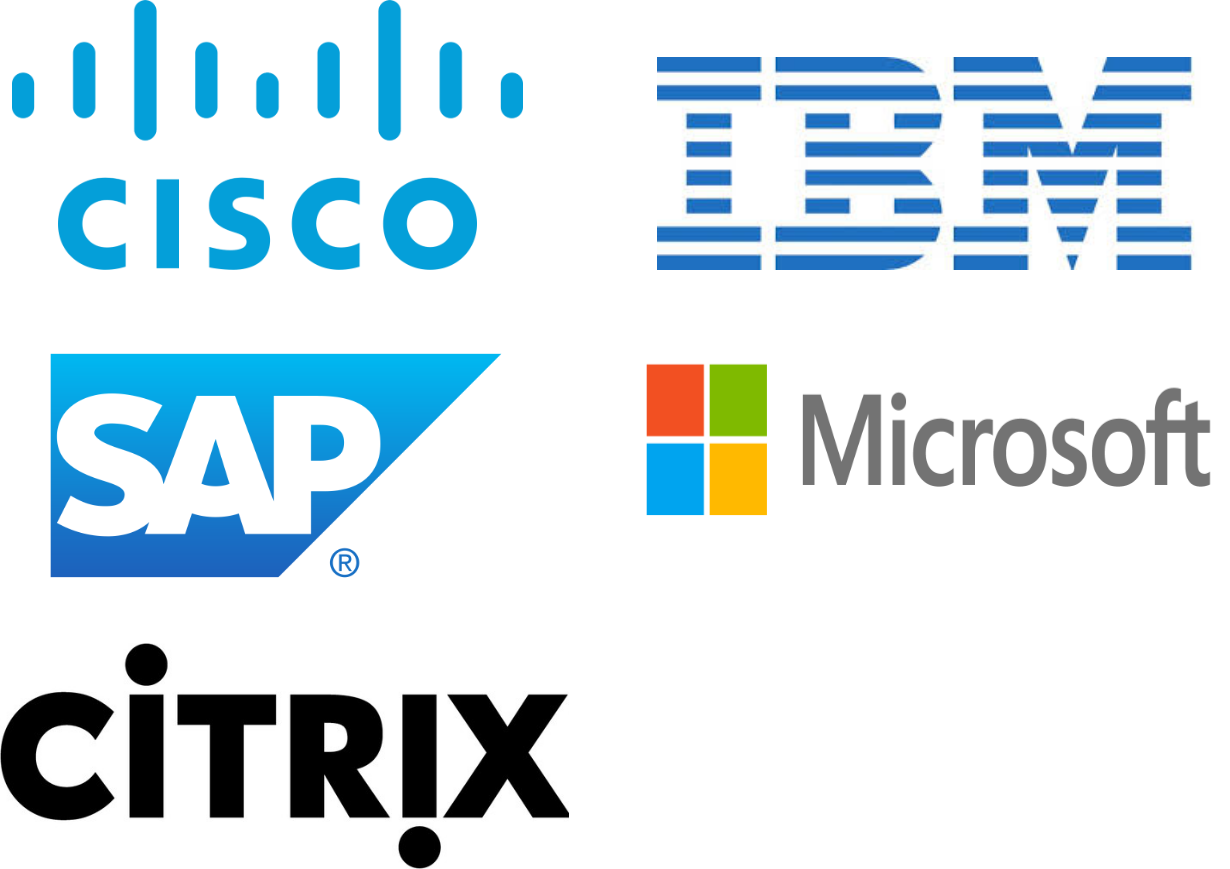Market Size of Enterprise Mobility in Retail Industry

| Study Period | 2019 - 2029 |
| Base Year For Estimation | 2023 |
| CAGR | 26.25 % |
| Fastest Growing Market | North America |
| Largest Market | North America |
| Market Concentration | High |
Major Players
*Disclaimer: Major Players sorted in no particular order |
Enterprise Mobility in Retail Market Analysis
The enterprise mobility in retail market is expected to register a CAGR of 26.25% over the forecast period of (2021-2026). According to the United States Census, Retail sales hit a record of USD 6 trillion in 2018. This is also a 50% increase from 2009's record low of USD 4.06 trillion.
- Differentiation in retail stores has never been more important than it is now. Consumers have more shopping options than ever before, from mass merchandisers to large retail departmental stores, offering one-stop discount shopping, and the convenience of the 24x7 global online marketplace.
- Retailers face relentless demands from consumers for more product choices, faster fulfillment, and improved service. Enterprise mobility can ease the burden of these demands, by implementing solutions such as in-store digitization mobility.
- The retail industry is generating huge amounts of data from its various channel modes - social sites, blogs, and from different apps. Much of this unstructured data is left unused, despite providing valuable information. With the introduction of e-commerce, the retail industry entered into the digital age, where retailers have the opportunity to collect more information about their customers.
- Leading retailers are leveraging enterprise mobility in retail services, to deliver better user experience and maximize store performance. From location analytics to drive engagement in order to understand shopper patterns, there is a fast-paced growth in retail expenditure, due to the rapid growth of urbanization.
- For instance, Snapchat and Amazon announced a partnership, which makes it easier to buy whatever Snapchat users come across in real life. Users point their Snapchat camera at a physical product or barcode and are then redirected to an Amazon pop-up card for that product, or something similar.
- Moreover, the integration of the Internet of Things (IoT) in the retail industry has increased, over the past few years, through the ascending utilization of devices such as RFID and sensor. According to Hewlett Packard Enterprise, 50% of retailers around the world, have adopted the IoT technology.
- However, to ensure that a retailer's network, data, application, and endpoints remain secure (away from any malware and breaches), several software applications and services are evolving to fulfill these requirements. According to NTT Security, the retail industry in APAC, the United States, and Australia were the sources of 93% of attacks.
Enterprise Mobility in Retail Industry Segmentation
| By Device | |
| Smart Phones | |
| Laptops | |
| Tablets | |
| Other Devices |
| Geography | |
| North America | |
| Europe | |
| Asia-pacific | |
| Latin America | |
| Middle East & Africa |
Enterprise Mobility in Retail Market Size Summary
The enterprise mobility in retail market is experiencing significant growth, driven by the increasing need for retailers to differentiate themselves in a competitive landscape. As consumers demand more product choices, faster fulfillment, and enhanced service, enterprise mobility solutions, such as in-store digitization, are becoming essential. The retail industry is generating vast amounts of data from various channels, including social media and apps, which, if harnessed effectively, can provide valuable insights. Leading retailers are adopting these mobility solutions to enhance user experience and optimize store performance. The integration of IoT devices, like RFID and sensors, is also on the rise, further supporting the industry's digital transformation. However, with the growing reliance on technology, ensuring the security of networks, data, and applications is paramount, prompting the development of advanced security software and services.
The e-commerce segment is the fastest-growing area within the retail sector, fueled by increased mobile and internet penetration worldwide. Mobile applications play a crucial role in this growth, offering retailers numerous opportunities and incentives to foster customer loyalty. Analyzing historical, location, and contextual data helps retailers improve sales strategies. As e-commerce continues to expand, particularly in regions like Latin America, the demand for enterprise mobility solutions is expected to rise, providing a competitive edge. North America is poised to hold the largest market share, supported by the high adoption of digital technologies and analytics among SMEs. The region's strong presence of enterprise mobility providers, coupled with investments and technological advancements, is driving market growth. Key players in this consolidated market include Cisco Systems Inc., IBM Corporation, and Microsoft Corporation, among others, who are focusing on enhancing mobility security and visibility through strategic partnerships and integrations.
Enterprise Mobility in Retail Market Size - Table of Contents
-
1. MARKET DYNAMICS
-
1.1 Market Overview
-
1.2 Introduction to Market Drivers and Restraints
-
1.3 Market Drivers
-
1.3.1 Substantial Growth in E-commerce
-
1.3.2 Increasing Adoption of Bring-your-own-device (BYOD)
-
-
1.4 Market Restraints
-
1.4.1 Security Concerns
-
-
1.5 Market Opportunities
-
1.5.1 Emergence of Enterprise Mobility Management Software
-
1.5.2 Increasing Use of Artificial Intelligence in Mobility Apps
-
1.5.3 Demand for Integrated Solutions
-
-
1.6 Industry Value Chain Analysis
-
1.7 Industry Attractiveness - Porter's Five Force Analysis
-
1.7.1 Bargaining Power of Buyers/Consumers
-
1.7.2 Bargaining Power of Suppliers
-
1.7.3 Threat of New Entrants
-
1.7.4 Threat of Substitute Products
-
1.7.5 Intensity of Competitive Rivalry
-
-
-
2. MARKET SEGMENTATION
-
2.1 By Device
-
2.1.1 Smart Phones
-
2.1.2 Laptops
-
2.1.3 Tablets
-
2.1.4 Other Devices
-
-
2.2 Geography
-
2.2.1 North America
-
2.2.2 Europe
-
2.2.3 Asia-pacific
-
2.2.4 Latin America
-
2.2.5 Middle East & Africa
-
-
Enterprise Mobility in Retail Market Size FAQs
What is the current Enterprise Mobility in Retail Market size?
The Enterprise Mobility in Retail Market is projected to register a CAGR of 26.25% during the forecast period (2024-2029)
Who are the key players in Enterprise Mobility in Retail Market?
Cisco Systems Inc., IBM Corporation, Microsoft Corporation, SAP SE and Citrix Systems Inc. are the major companies operating in the Enterprise Mobility in Retail Market.

